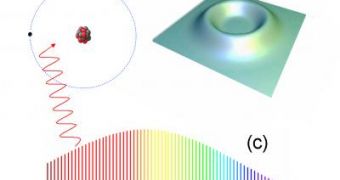Rydberg's constant, is a physical measure specifying the exact light frequency given off by an atom while an electron jumps from a certain energy level to a lower one. This number is critical for light spectroscopy techniques trying to determine the concentrations and types of chemical elements inside distant stars or even in studies measuring the amounts of pollutants in Earth's atmosphere. Max Planck Institute for Physics and National Institute of Standards and Technology researchers propose an experiment that should be able to measure Rydberg's constant with an accuracy rate 500 times greater than the one currently available.
They hope that by inserting an electron into an orbit around an atomic nucleus they will be able to measure the maximum possible orbital distance that would keep the atom into a stable configuration. Rydberg's constant has been previously determined through theoretical and experimental work involving 23 energy levels inside the atoms of hydrogen and deuterium isotope. Constant accuracy is now about 6.6 parts per trillion, but the new experiment promises an accuracy rate of at least 14 part per quadrillion.
Uncertainties
The exact value for Rydberg's constant cannot be measured due to the nucleus size uncertainties, which can alter the wavelength of emitted light by modifying the electron's energy levels. Alternatively, electrons may also interact with the nucleus through virtual particles, which has basically the same effect as in the previous case. By inserting electrons into an orbit around the hydrogen nucleus at high energy levels, the orbital distance is increased and virtual particle transfer is decreased to a minimum, thus reducing theoretical uncertainties by as much as 10 parts per quintillion.
According to NIST researchers, the experiment will involve stripping all electrons of hydrogen atoms before cooling them, in order to insert high orbital electrons. Sensitive equipment would measure the frequency of the light absorbed by the atoms, to obtain a greatly improved value for the Rydberg constant. Additionally, the experiment, which is to be carried out at the Electron Beam Ion Trap Facility at NIST, could achieve a sensitivity so high that it may even reveal electrodynamic quantum anomalies.

 14 DAY TRIAL //
14 DAY TRIAL //